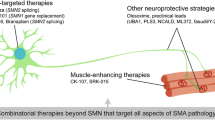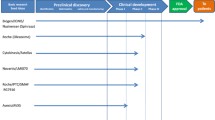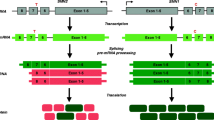Abstract
Purpose of Review
Spinal muscular atrophy (SMA) is a genetic disorder of motor neurons in the anterior horns of the spinal cord and brainstem that results in muscle atrophy and weakness. SMA is an autosomal recessive disease linked to deletions of the SMN1 gene on chromosome 5q. Humans have a duplicate gene (SMN2) whose product can mitigate disease severity, leading to the variability in severity and age of onset of disease, and is therefore a target for drug development.
Recent Findings
Advances in preclinical and clinical trials have paved the way for novel therapeutic options for SMA patients, including many currently in clinical trials. In 2016, the first treatment for SMA has been approved in the USA, an antisense oligonucleotide that increases full-length protein product derived from SMN2.
Summary
The approval of a first treatment for SMA and the rapid advances in clinical trials provide the prospect for multiple approaches to disease modification. There are several other promising therapeutics in different stages of development, based on approaches such as neuroprotection, or gene therapy.

Similar content being viewed by others
References
Papers of particular interest, published recently, have been highlighted as: • Of importance •• Of major importance
Kolb SJ, Kissel JT. Spinal muscular atrophy: a timely review. Arch Neurol. 2011;68(8):979–83.
• Pechmann A, Kirschner J. Diagnosis and new treatment avenues in spinal muscular atrophy. Neuropediatrics. 2017; This paper gives an overview of diagnosing SMA as well as reviews standard of care practices and provides a timeline of the development of therapeutics for SMA
Wen-Yo T, Simpson JE, Highley JR, Heath PR. Spinal muscular atrophy: factors that modulate motor neurone vulnerability. Neurobiol Dis. 2017;102:11–20.
• Burghes AHM, Beattie CE. Spinal muscular atrophy : why do low levels of survival motor neuron protein make motor neurons sick? Nature Reviews. 2009;10:597–609. The author provides a detailed review of the function of SMN and discusses hypotheses for why low SMN leads to SMA and why it targets motor neurons
Arnold WD, Kassar D, Kissel JT. Spinal muscular atrophy : diagnosis and management in a new therapeutic era. Muscle Nerve. 2015;51:157–67.
Grotto S, Cuisset JM, Marret S, et al. Type 0 spinal muscular atrophy: further delineation of prenatal and postnatal features in 16 patients. J Neuromuscul Dis. 2016;3:487–95.
Pera MC, Coratti G, Forcina N, et al. Content validity and clinical meaningfulness of the HFMSE in spinal muscular atrophy. BMC Neurol. 2017;17(39):1–10.
• Bishop KM, Montes J, Finkel RS. Motor milestone assessment of infants with spinal muscular atrophy using the Hammersmith infant neurological exam—part 2: experience from a nusinersen clinical study. Muscle Nerve. 2017:1–4. The authors discuss the reliability and feasibility of the use of the HINE-2 scale for assessing infants with SMA in response to therapeutics and in clinical trials
Iannaccone ST. Outcome measures for pediatric spinal muscular atrophy. Arch Neurol. 2002;59:1445–50.
Seferian AM, Moraux A, Canal A, et al. Upper limb evaluation and one-year follow up of non-ambulant patients with spinal muscular atrophy: an observational multicenter trial. PLoS One. 2015;10(4):e021799.
Bonati U, Holiga S, Hellback N, et al. Longitudinal characterization of biomarkers for spinal muscular atrophy. Ann Clin Transl Neurol. 2017;4(5):292–304.
Oskoui M, Levy G, Garland CJ, et al. The changing natural history of spinal muscular atrophy type 1. Neurology. 2007;69(20):1931–6.
Finkel RS, McDermott MP, Kaufmann P, et al. Observational study of spinal muscular atrophy type I and implications for clinical trials. Neurology. 2014;83(9):810–7.
Kaufmann P, McDermott MP, Darras BT, et al. Prospective cohort study of spinal muscular atrophy types 2 and 3. Neurology. 2012;79(18):1889–97.
• Mercuri E, Finkel R, Montes J, et al. Patterns of disease progression in type 2 and 3 SMA: implications for clinical trials. Neuromuscul Disord. 2016;26:126–31. This paper reports on one of the largest sets of longitudinal data in ambulant and nonambulant patients with type 2 and type 3 SMA and describes the change in the Hammersmith Functional motor scale over time
•• Calder AN, Androphy EJ, Hodgetts KJ. Small molecules in development for the treatment of spinal muscular atrophy. J Med Chem. 2016;59:10067–83. This paper provides an overview of prior and novel small molecule compounds and reviews their biochemical properties, mode of action, and for previously tested repurposed drugs provides a review of the trial data for those compounds
• Farrar MA, Park SB, Vucic S, et al. Emerging therapies and challenges in spinal muscular atrophy. Ann Neurol. 2017;81:355–68. This paper provides a review of novel therapies for SMA, and provides useful figures and tables that highlight the mechanism and targeted site of action for these drugs
Swoboda KJ, Scott CB, Crawford TO, et al. SMA CARNI-VAL trial part I: double-blind, randomized, placebo-controlled trial of L-carnitine and valproic acid in spinal muscular atrophy. PLoS One. 2010;5(8):e12140.
Kissel JT, Scott CB, Reyna SP, et al. SMA CARNIVAL trial part II: a prospective, single-armed trial of L-carnitine and valproic acid in ambulatory children with spinal muscular atrophy. PLoS One. 2011;6(7):e21296.
Wadman RI, Bosboom WM, van den Berg LH, et al. Drug treatment for spinal muscular atrophy types II and III. Cochrane Database Syst Rev. 2011;12:CD006282.
Bertini E, Dessaud E, Mercuri E, et al. Safety and efficacy of olesoxime in patients with type 2 or non-ambulatory type 3 spinal muscular atrophy: a randomised, double-blind, placebo-controlled phase 2 trial.
•• Scoto M, Finkel RS, Mercuri E, Muntoni F. Therapeutic approaches for spinal muscular atrophy (SMA). Gene Therapy. 2017; This article provides a timely review of therapies for SMA including a focus on recent clinical trials and novel advances including gene replacement
Zanetta C, Nizzardo M, Simone C, et al. Molecular therapeutic strategies for spinal muscular atrophy: current and future clinical trials. Clin Ther. 2014;36(1):128–40.
•• Finkel RS, Chiriboga CA, Vajsar J, et al. Treatment of infantile-onset spinal muscular atrophy with nusinersen: a phase 2, open-label, dose-escalation study. Lancet. 2016;388:3017–26. This paper provides data on the use of nusinersen with type I SMA and reviews safety, motor functional, and electrophysiologic outcome measures as well as critical biodistribution and histologic data that was obtained from autopsy of three patients
Meyer K, Ferraiuolo L, Schmelzer L, et al. Improving single injection CSF delivery of AAV9-mediated gene therapy for SMA: a dose-response study in mice and nonhuman primates. Mol Ther. 2015;23:477–87.
https://www.medpagetoday.com/meetingcoverage/aan/64817 (accessed June 21, 2017).
•• Wang CH, Finkel RS, Bertini ES, et al. Consensus statement for standard of care in spinal muscular atrophy. J Child Neurol. 2007;22(8):1027–49. This paper has led to a shift in clinical practices in order to improve standards of care and overall health for patients with SMA over the past ten years
Phan HC, Taylor JL, Hannon H, et al. Newborn screening for spinal muscular atrophy: anticipating an imminent need. Semin Perinat. 2015;39:217–29.
Wadman RI, Bosboom WM, van den Berg LH, et al. Drug treatment for spinal muscular atrophy type I. Cochrane Database Syst Rev. 2011;12:CD006281.
Author information
Authors and Affiliations
Corresponding author
Ethics declarations
Conflict of Interest
The authors declare that they have no conflict of interest.
Human and Animal Rights and Informed Consent
This article does not contain any studies with human or animal subjects performed by any of the authors.
Additional information
The views expressed are those of the authors and do not reflect official NIH perspectives or policies.
This article is part of the Topical Collection on Nerve and Muscle
Rights and permissions
About this article
Cite this article
Bharucha-Goebel, D., Kaufmann, P. Treatment Advances in Spinal Muscular Atrophy. Curr Neurol Neurosci Rep 17, 91 (2017). https://doi.org/10.1007/s11910-017-0798-y
Published:
DOI: https://doi.org/10.1007/s11910-017-0798-y




